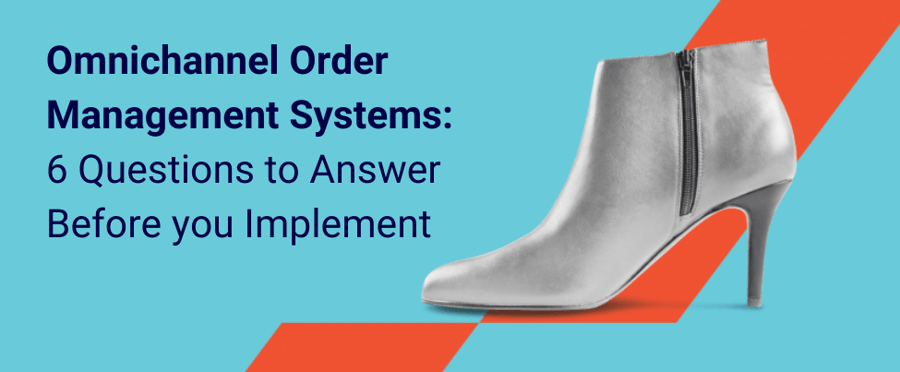6 questions to ask before you implement an Order Management System


Before you embark on an OMS implementation, you’ll need to make sure that you have a full view of what to expect, how to track performance, and how to measure the contribution your OMS makes to your bottom line.
Ensure you have the right tools to measure – and ensure – OMS success. Start with this video from Manhattan Associates which gives you the ultimate overview of Manhattan Active™ Omni, our Order Management System of choice.
Read more about our omnichannel fulfilment solutions here.
Before you begin the process of implementing and activating a new Order Management System, it's critical to map your OMS functional requirements and desired outcomes.
The 6 most important questions to answer to plan your OMS:
1. What are your immediate business goals, and how will your OMS help you to achieve them after go-live?
The streamlining and organisation of your order management process flow is a given, but look a little bit deeper to ensure you have a comfortable understanding of what you can achieve as an immediate benefit.
With full integration, your OMS will have an impact on every part of your business, from order processing to CRM, forecasting and purchasing, inventory management and the full customer experience.
Pinpoint the immediate benefits, drawbacks, and challenges to ensure you can achieve these goals without the last-minute hurdles.
2. How is your OMS performance measured and tracked after go-live, and what KPIs should you be driving?
These are some examples of KPIs which can be improved through the OMS:
- Improve the customer experience by reducing lead times
- Support omnichannel payments
- Offer endless aisle on all channels
- Save the sale in the store.
- Optimise your inventory allocation throughout the network.
Your OMS will be integrated with internal and external processes, like e-commerce websites, shippers, retail channels, marketing processes, and fraud prevention services. With this in mind, your unified order management system will have a number of critical benchmarks to reach and exceed.
With all your data in a centralised location, you’ll have the means to consolidate, analyse, and optimise your processes efficiently. What reporting will you require, and how will your KPIs be tracked effectively to give a full view of your gains and results?
3. What are your long-term objectives and ambitions for your Order Management System?
Centralised data allows you to make quicker, more accurate decisions on a day-to-day basis, and gives you real-time information that drives long-term improvement. With current and historical data, you can achieve long-term goals through better planning.
For example, consider your current vs. future inventory replenishment goals, purchasing and stock management objectives, and marketing campaigns you’d like to run, and check off the ways in which your OMS can help you to drive these ideals.
Consider the changing requirements, growth objectives, and industry needs, and ensure your implementation is agile enough to handle these potential developments.
Since the OMS will serve at the core of your business, it’s a great opportunity to bring the business capabilities to a level where your customer experiences the interactions with your brands as interconnected and seamless, regardless of the channel.
Implementing your OMS to ensure it supports your long-term business objectives is just as – if not more – important than the “right here, right now” benefits.
4. What strategy are you using to improve customer experience for your brands and business?
Your Order Management System must provide support across your omnichannel business to improve the outcome for customers.
This may be through error reduction in accounting, shipping, delivery, as well optimisation in inventory availability and order orchestration; it could also help to improve turnaround times and increase the time spent on Customer Relationship Management.
The OMS allows you to experiment, learn, improve, and deploy the improved customer experience quickly across brands and markets, allowing your business to scale, improve margin and ensure that your implementation drives a large portion of your Customer Experience objectives, from start to finish.
5. How do you plan to reduce your costs and improve your margins within your business?
Your OMS should give you the tools to take savings a step further. Which of these savings gives you the most leverage in your profitability drive?
- Error reduction by enabling more dynamic inventory availability and fulfilment optimisation focused on the customer promise
- Software expense reduction by consolidating financial reconciliation triggers, inventory management, customer service, shipping, and marketing tools into a single package.
- Reduce returns and losses by using real-time data to explain the trends in product returns or failures.
- Using your data to assess your fulfilment & shipping expenses to, ultimately, reduce the cost to customer.
6. Your sales channels may increase. Which avenues may come into play at a later date, and how do you plan to incorporate them?
The digital and retail environment is evolving, and with evolution and development will come new channels, improved uptake of existing channels, and elimination of outdated sales methods.
Enabling as much flexibility and future-proofing as possible will allow your business to add, remove, or improve sales channels as and when required.
Critically, your product sales on the likes of Amazon, Takealot, and other channels are dependent on a well-integrated OMS which will allow you to list your products, dynamically advertise inventory availability based on the channel or even customer and deliver orders to your customers by the promised date, while evaluating the best fulfilment options.
These are the thought starters for your Order Management System implementation, and a discussion should be had with your vendor in the Middle East or South Africa around each point to ensure all possibilities and challenges are addressed.
To discuss an order management system implementation, whether you are starting from scratch or require integration, set up a free consultation with Supply Chain Junction.
TAGS
- WMS (51)
- Warehouse Best Practice (46)
- Implementing a WMS (29)
- Managing your warehouse (19)
- Omni Channel (18)
- eCommerce (18)
- Blog (16)
- Supply Chain Best Practice (16)
- Customer Journey (9)
- Mid-Level (8)
- Warehouse optimisation (7)
- General Tips (5)
- Industry General (5)
- Information (5)
- Trends (5)
- managing your Supply Chain (5)
- saudi arabia (5)
- Press Release (4)
- smart warehouse (4)
- 3PL (3)
- News (3)
- ERP (2)
- Entry-level (2)
- ROI (2)
- Case Study (1)
- OMS (1)
- Picking (1)
- Solution-Specific (1)
- Transport Management System (1)
Take A Look At The Results Of A Successful WMS Implementation.
See how Tarsus Distribution, in collaboration with SCJ boost overall efficiency by 60%




